Though its eastern border is now Morgan Street, the neighborhood of Little Italy once continued east along Taylor Street all the way to Canal Street.  The neighborhood was much larger until its eastern half was demolished for the University of Illinois Chicago and the Dan Ryan Expressway. That half, bounded by Halsted, Roosevelt, Canal, and Harrison Streets, has historically been interspersed with commercial and industrial buidings. Today, it is dominated by them.
The neighborhood was much larger until its eastern half was demolished for the University of Illinois Chicago and the Dan Ryan Expressway. That half, bounded by Halsted, Roosevelt, Canal, and Harrison Streets, has historically been interspersed with commercial and industrial buidings. Today, it is dominated by them.
The map at right shows the area we’re looking at in red, and the last remaining residential structure in that area is represented by the green dot.
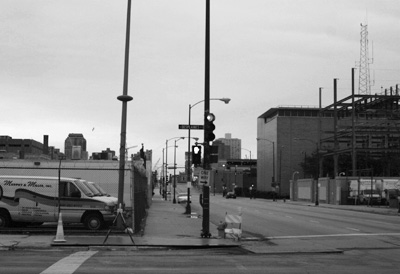
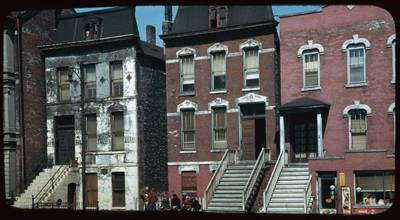
Right: Charles Cushman, Indiana University Archives.
The corner of Taylor and Desplaines. The area has a semi-deserted industrial park feel. The large brick building in the right of the right image is the Chicago Fire Academy, built on the location where the great Chicago Fire (supposedly) began. Prior to the Fire Academy, which was built in 1962, DeKoven street was residential.
The house on the left side of the right image stood at 558 DeKoven, where the great Chicago Fire (again, supposedly) started. Photographed in 1949 by Charles Cushman, this is obviously not Mrs. O’Leary’s barn, but a mansard roofed three-flat built by Anton Kolar in 1880. It is barely visible in this view, but there is a Charter Jubilee plaque on the house, as well as an older inset limestone plaque, both indicating the site’s historical importance.
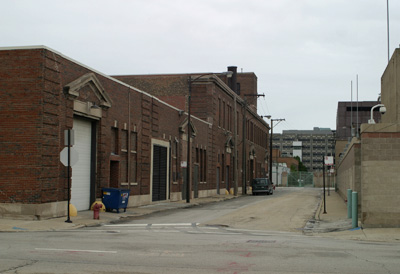

Left: Cabrini and Jefferson, two views as well. Most of this area is zoned Downtown Service and contains many city buildings, substations, and warehouses, in addition to a new retail development at Canal and Roosevelt.
Right Desplaines Street facing north with the Presidential Towers in the background.

DN-0005903, Chicago Daily News negatives collection, Chicago Historical Society.
|
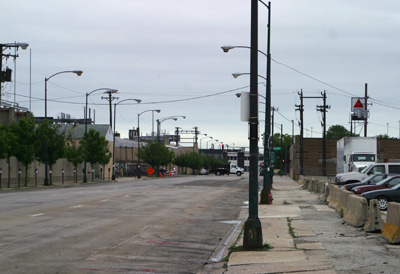 Above: Desplaines facing south from Cabrini Street. The vacant area at right is the former location of Dante School.
Left: Dante School, the elementary school which served this area, shown here in 1908.
Above: Desplaines facing south from Cabrini Street. The vacant area at right is the former location of Dante School.
Left: Dante School, the elementary school which served this area, shown here in 1908.
|
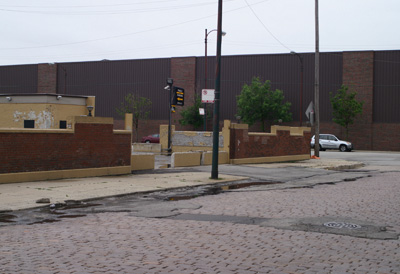
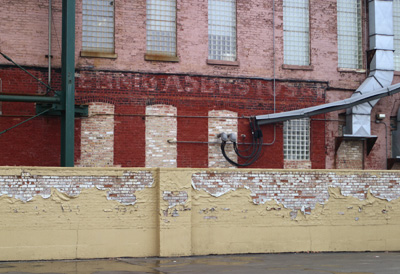
Left: Some belgian block paving on Vernon Park behind the new county courthouse. The wall surrounding the parking lot was formerly a building, and one of the more interesting parking lot fences around.
Right: A fading sign for an asbestos company. Considering all of the turn-of-the-century buildings that were demolished in this area over the years, this is a curiosity. One would think such a building would have gone when asbestos was found to be as dangerous as it is.

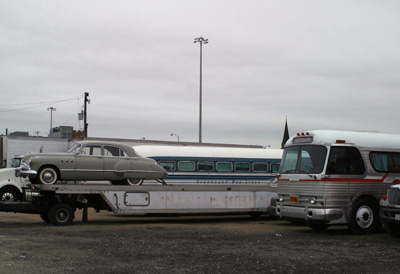
The corner of Polk and Jefferson. The old main post office is commanding from this vantage point. Speaking of the old post office, it was being used as a set for the Dark Knight at the time these images were taken. The empty lot that used to be Dante school was being used to house a number of classic vehicles, undoubtedly for the Dark Knight as well.

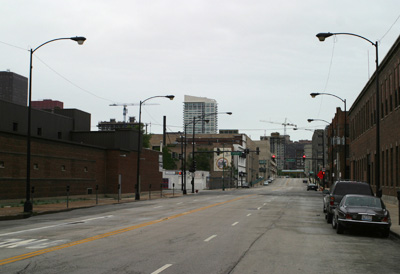
Polk at Desplaines, looking west and east respectively.
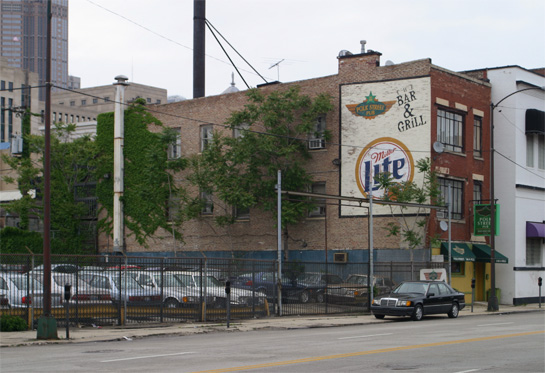
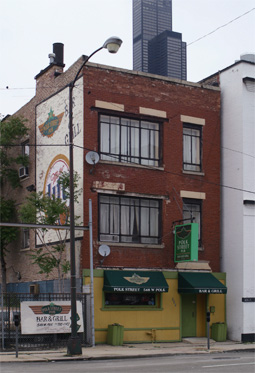
A single residential structure remains in the area, a three-flat near the corner of Polk and Clinton Streets. The ground floor of the building houses the Polk Street Pub which never appears to actually be open, although we are told that it is indeed in business. The building fit into its surroundings very well when it was built around 1908, but today it stands out almost anachronistically. Any ornament it would have had has long been removed, most notably the cornice. The ground floor is painted in color scheme reminiscent of an avocado.
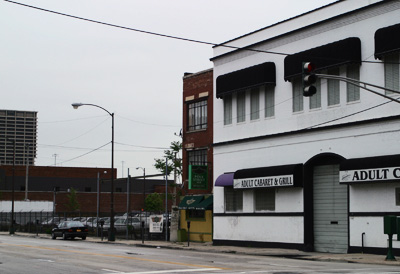
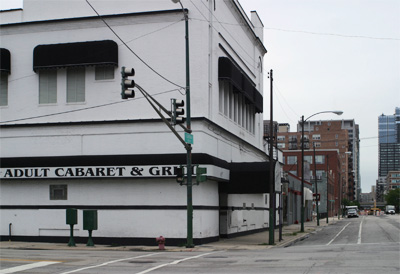
The Little Whorehouse That Couldn’t. The fact that they advertise as an “Adult Cabaret & Grill” is amusing. Would anyone go here simply to eat lunch? To grab a burger? Apparently so — a reader wrote in describing it as a popular lunch spot. Lunch or not, strip clubs are becoming a rare breed as Chicago becomes more and more Disney-fied. Scarlett’s went out of business at some point in 2007, and the building has since been relieved of its garish white paint job.
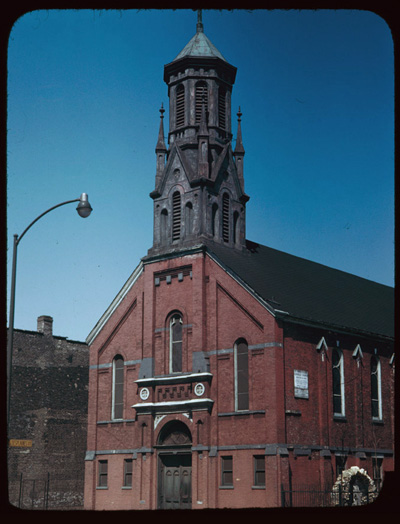
Charles Cushman, Indiana University Archives.
|
We leave you with another Charles Cushman image from 1949. Cushman had a knack for photographing that which would soon be no longer. This is St. Wenceslaus Catholic Church, built in 1865. Though it was at ground zero of the Great Fire at Desplaines and DeKoven, it survived. Divine intervention? However, as with most of the rest of this area, it did not survive Daley’s demolition machine. |
Read More
This article was last updated
on Thursday, January 8th, 2009 at 2:17 pm.
 The neighborhood was much larger until its eastern half was demolished for the University of Illinois Chicago and the Dan Ryan Expressway. That half, bounded by Halsted, Roosevelt, Canal, and Harrison Streets, has historically been interspersed with commercial and industrial buidings. Today, it is dominated by them.
The neighborhood was much larger until its eastern half was demolished for the University of Illinois Chicago and the Dan Ryan Expressway. That half, bounded by Halsted, Roosevelt, Canal, and Harrison Streets, has historically been interspersed with commercial and industrial buidings. Today, it is dominated by them. 




 Above: Desplaines facing south from Cabrini Street. The vacant area at right is the former location of Dante School.
Left: Dante School, the elementary school which served this area, shown here in 1908.
Above: Desplaines facing south from Cabrini Street. The vacant area at right is the former location of Dante School.
Left: Dante School, the elementary school which served this area, shown here in 1908.














